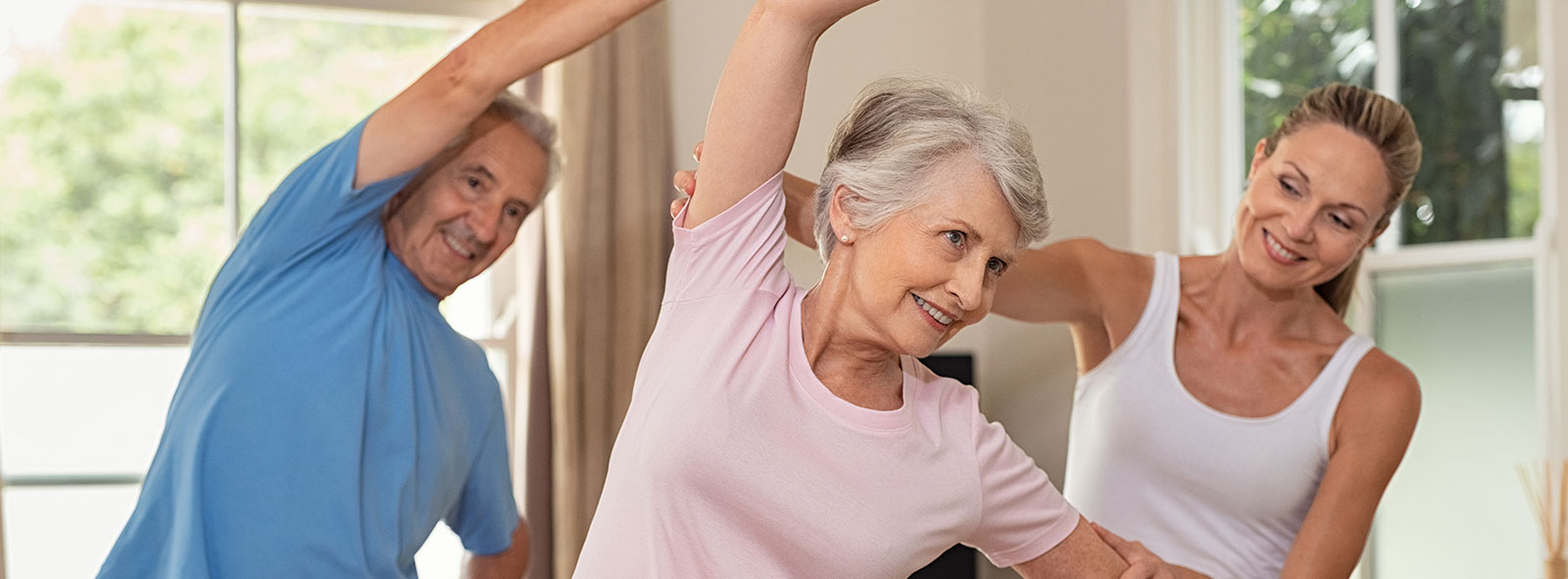Get Unbelievable Benefits from these 9 Exercises for Seniors
Everyone knows that exercise is great for your health, but did you realize it can also help prevent falls?
Low impact exercises for seniors can not only prevent falls, but they can help you recover faster if you have a fracture or injury as a result of falling. These exercises are great, particularly those who are undergoing hip physical therapy or who are participating in inpatient rehab physical therapy.
We’re going to take a look at the 9 most beneficial exercises for older adults, how to do them and how you can benefit.
9 Types of Low Impact Exercises for Seniors
- Brisk walking
This is not only an easy exercise—all you need are a good pair of walking shoes—but it can increase your heart rate. If you’re looking for a good place to walk, go to your local shopping mall and join the ranks of “mall walkers.” (You can find more information from the National Institute on Aging)
If you’ve recently had a hip physical therapy, speak with your doctor or physical therapist about when it is safe to start a walking routine.
Not sure where to start? Here are some helpful guidelines.
- If you find you’re taking less than 5,000 steps a day, gradually start to add 3,000 to 4,000 more steps a day.
- If you’re achieving roughly 8,000 steps a day, you’re likely meeting the recommended activity level.
- Aim for getting 10,000 or more steps each day. Once you are comfortable with that, and then add 5,000 more steps a day.
- Yoga
Yoga is a relaxing exercise that can provide a lot of great benefits for seniors. However, it’s important—particularly if you are a beginner—to practice yoga safely. If you’ve had a joint replacement, you should speak to your doctor about whether or not this exercise is a good choice for you.
If interested, you can look for classes called gentle yoga or senior yoga, specially geared for beginners or older adults.
- Weight training
With one out of every three older adults experiencing severe muscle loss, weight training is one of the great, effective core exercises for seniors. Don’t worry, weight training doesn’t mean lifting a ton of weight. That’s not necessary to reap the benefits from weight training.
The best way is to start small. Try chair squats, wall pushups and stair climbing. Weight training is great in reducing the amount of age-related abdominal fat, which is a key indicator of overall health.
- Cardiovascular low-impact exercises for seniors
If you perform low-impact aerobics, you’re less likely to lose muscle function as you age. Before beginning an aerobics program, speak to your doctor to ensure this type of exercise is right for you and your needs. Consider using equipment such as a treadmill, elliptical machine, a rowing machine or a stationary bike.
- Biking
This is a great family activity that is a perfect outdoor activity. Explore the bike trails and paths that are near you. Remember to always wear a helmet and practice good bike safety principles as outlined by the North Carolina Department of Transportation.
- Tai Chi
Tai Chi is a slow, almost meditative, series of movements designed to enhance balance. As a restful, research has shown that seniors who practice tai chi are much less likely to fall. It also can enhance your heart health, ease pain from arthritis and even improve your sleep, according to information from the National Institute on Aging.
- Silver Chair aerobics
Chair aerobics is a great way to get moving without causing stress on joints. It’s a perfect workout for seniors.
- Pickleball
Similar to tennis, this sport is popular in retirement communities throughout the country. It is a combination of tennis and ping pong. According to the AARP, a study linked playing pickleball to lower blood pressure, improved cardiovascular fitness and enhanced mood.
- Flexibility training exercises
Flexibility is important to keep your muscles healthy and improve your balance. The National Institute on Aging recommends some of these useful flexibility training exercises.
How Much Activity Should Older Adults Get?
Each week you should aim for at least 150 to 300 minutes of moderate-intensity activity. However, if you participate in vigorous activity, you can exercise the equivalent amount of 75 to 150 minutes, according to information from the Centers for Disease Control.
Inpatient Rehab Therapy
If you’re receiving inpatient rehab therapy, your therapist may have a specific set of exercises he or she would like for you to follow. It’s very important to speak with them to ensure you’re exercising safely and correctly.
Planning to Be in Physical Therapy Rehabilitation? Remember This Before You Start Exercising
We recommend that you get a regular check-up and talk with your doctor about what would be an appropriate exercise. If you’ve had a hip or knee replacement and are participating in physical therapy rehabilitation, it’s important to review your plans with your health care team.
Often, the activities you can participate in depend upon how well you are recovering after the surgery.
When you exercise be sure you take adequate time to warm up. This helps you avoid injuries.
In addition, you should also stay hydrated by drinking water. It’s best to avoid many sports drinks and sodas because most of them have a large amount of sugar.
If you’re lifting weights or doing stretching exercises, be sure to concentrate on your form. Lifting incorrectly can cause sprains and strains. If you’re unsure, ask your therapist who is conducting your physical therapy rehabilitation.
West Bladen: Where Quality Inpatient Rehab Therapy Makes a Difference
Have you had a recent fall? West Bladen offers the services you need from highly trained experts who will help you. We’re dedicated to not only providing the best in compassionate care, but we do so in an environment that is relaxing and therapeutic.
See why our residents love West Bladen, where a friendly staff immediately makes you feel right at home. Contact us for more information or to schedule a tour.


